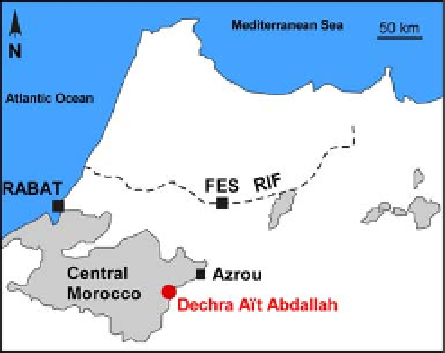Geoscience Reference
In-Depth Information
Azrou and 10 km NW of M'rirt. The locality is
described in Termier & Termier (1950). It consists
of a 30 m thick section of marine grey-to-dark
laminated limestones. Several plant beds have
been discovered (work in progress at Montpellier),
but the specimen described here was collected
from a loose block found near the base of the
section.
Several Tentaculita specimens have been col-
lected from seven successive layers. They belong
to the genera Styliolina Karpinsky (Styliolinida)
and Viriatellina Bou
ˇ
ek (Nowakiida). Most of
them are too badly preserved for any firm specific
attribution. Nevertheless, some specimens from a
level at the very base of the section, below the Relli-
mia level, could be identified as Viriatellina pseudo-
geinitziana armoricana Lardeux, a subspecies of
V. pseudogeinitziana (Bouˇek 1964) that indicates
a late Emsian age (late Lower Devonian; Lardeux
1969). This is consistent with the discovery, close
to Rellimia and within a lower horizon of the
section, of a trilobite assignable to Struveaspis mar-
occanum, a species ranging from the late Emsian
to the early Eifelian (R. Feist, pers. comm., 2008).
All attempts to recover identifiable spores from
the sediments were unsuccessful.
Fig. 1. Location of Dechra A¨t Abdallah, the
fossiliferous locality in Morocco.
They identified seven taxa: Asteroxylon elberfel-
dense Kra ¨sel & Weyland, Psilophyton princeps
Dawson, Hyenia cf. elegans Kra¨sel & Weyland,
Aneurophyton maroccanum nov. sp., Scougouphy-
ton abdallahense nov. gen. nov. sp., Cordaianthus
devonicus Dawson, 'Archaeopteris' rotundifolia
nov. sp. and incertae sedis specimens. Several
authors do not recognize A. maroccanum as a
valid species of Aneurophyton (Schweitzer &
Matten 1982; Fairon-Demaret & R´gnault 1986).
The recognition of Cordaianthus in Devonian beds
is problematic and that of Archaeopteris foliage
in supposedly Eifelian deposits is suspicious.
The diversity of this assemblage and the obvious
need for its taxonomic revision encouraged us to
revisit the locality during a field trip organized in
2000 where we collected a various assemblage of
fossil plants together with some new Tentaculita.
Despite the report of supposedly fertile specimens
by Termier & Termier (1950), we found that such
remains were very rare at Dechra A¨t Abdallah.
This fact seriously limited the accurate taxonomic
identification of the specimens. The present paper
focuses on the coalified compression of a fertile
plant showing the distinctive features of the aneuro-
phytalean progymnosperm Rellimia (Leclercq &
Bonamo 1973). The occurrence at the locality of
this specimen had already been signalled (Gerrienne
et al. 2002), but had not been illustrated. Its report in
north Africa is a contribution to the elaboration of a
more complete Devonian plant database than those
currently available today. The bearing of the occur-
rence
Methods
Only one specimen was collected; the counterpart
is missing. The plant fossil was studied using stan-
dard palaeobotanical methods for compressions,
mainly d´gagement (Fairon-Demaret et al. 1999).
The specimen was then embedded and macerated
in hydrofluoric acid (transfer technique of Banks
et al. 1972) in order to obtain information on
anatomy and spores. This attempt was unsuccessful,
but allowed a better image of the fertile part of
the specimen (Fig. 2b). The specimen was photo-
graphed using a Nikon D70 camera with a polarized
light source. The contrast between plant and matrix
was
enhanced
by
wetting
the
specimen
with
distilled water.
Description and identification
of the specimen
The specimen consists of a 6.5 cm long portion of a
main axis bearing at least three lateral fertile organs
in spiral order (Fig. 2a, A - C). Both ends of the main
axis are missing, but the size and conicity of the
specimen suggest that it may correspond to a
distal portion. The main axis is about 2.5 mm wide
proximally and tapers to a diameter of 1.5 mm dis-
tally. Intervals separating the three fertile organs
labelled A - C average 1 cm in length. The fertile
organs are about 2 cm long and are adaxially
recurved towards the main axis. They comprise
of
Rellimia
to
Devonian
phytogeography
is discussed.
Locality and stratigraphy
The Dechra A¨t Abdallah plant beds are situated in
Central Morocco (Fig. 1), about 40 km SW of

